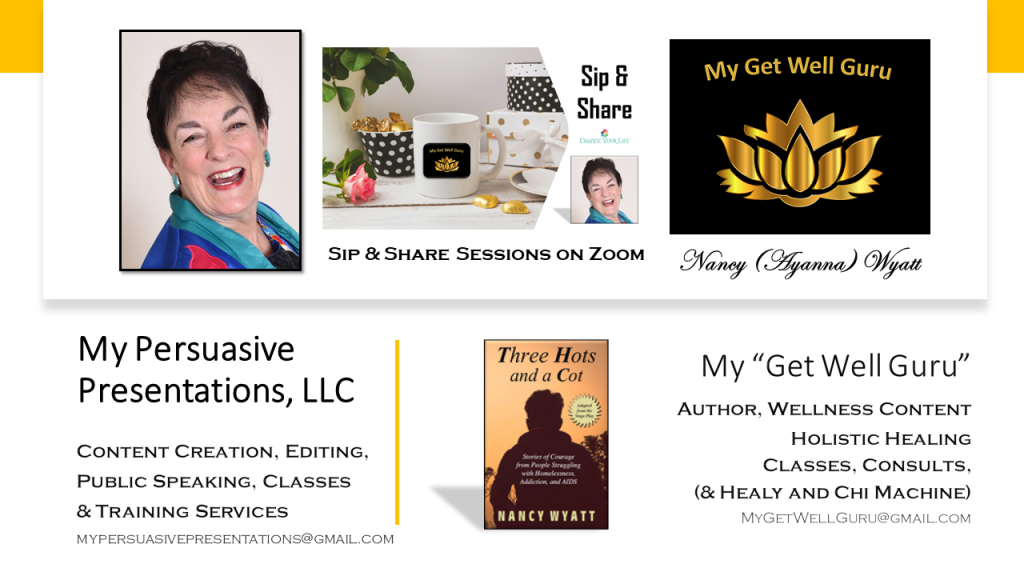What do we need to know about Pics & Poetry Publishing?
 Known as The Occasional Poet, I teach people how to put their poems into PowerPoint presentations that can be converted to video presentations for professional use or because they want to leave a legacy for their families and friends. However, now, I want to write a book filled with poetry that I have written and photos I have taken. Do you, too?
Known as The Occasional Poet, I teach people how to put their poems into PowerPoint presentations that can be converted to video presentations for professional use or because they want to leave a legacy for their families and friends. However, now, I want to write a book filled with poetry that I have written and photos I have taken. Do you, too?
Have you thought of publishing poetry (with or without photos), but don’t know where to start? Me, too!
I published a non-fiction book of true stories (Three Hots and a Cot) about people who were homeless, addicted, and/or had AIDS, but my poems have been published only in anthologies, and someone else did all the work.)
Therefore, comma, I found some references for us to get us jump-started. Compiling and publishing that book will make a great project for us as the winter sets in soon. So, grab your coffee and learn with me now.
But, First, Let’s Talk About Themes

With or without pictures, a book of poems benefits from having a theme, however loosely construed. Yet, mirroring the rest of my life and personality, I write poetry on themes that are “all over the place.” So, one challenge you might share with me is that of selecting items for publication that have some sort of thread that will interest the readers I/we hope to attract. Below are some suggestions.
Pics & Poetry Publications
Seasonal Spring, Summer, Fall, and Winter
The book could have a collection of several works in each category. Topics are likely to be about seasonal landscapes, moods, weather, etc.
Alternatively, it could have a cyclical style of one poem in each of the four seasons … rinse and repeat.
- In the latter version, the poems could be about landscapes, flowers blooming, squirrels gathering nuts, or blizzard whiteouts. BUT
- Instead, those selections could be about things that happened in your life as the seasons pass…rather like the beloved, long-running movie, The Four Seasons. It tracks societal changes and their effects on the personal lives of a couple of sweethearts over the decades of their lives.
- A third idea is compiling a selection of poems related to seasonal holidays or Holy Days, depending on your bent.
Pics & Poetry Publications
Compilation by Style of Poetry
Scribophile offers a list and description of 28 types of poetry.

I’ll share a short list of the most common styles, but please visit their website https://www.scribophile.com/academy/types-of-poetry to see the names and descriptions of many more.
- Blank verse – non-rhyming poetry written with a precise meter – usually using iambic pentameter.
- Rhymed poetry – metrical (rhythmical), rhymed verse
- Free verse – written without using a precise meter, style, rhyme scheme, or structure.
- Epic – a long narrative about a journey, or a nation, often with a heroic figure, who commits extraordinary deeds in unusual circumstances, as the center of the storyline.
- Narrative poetry – storytelling. It might use the voices of both a narrator and characters.
- Limerick .- a short poem consisting of five lines that rhyme AABBA. They are storytelling with humor, which might be quite bawdy.
- The first two lines should have eight or nine syllables each, the third and fourth lines should have five or six syllables each, and the final line eight or nine syllables again.
- Cinquain – a poem consisting of five lines and twenty-two syllables: two in the first line, then four, then six, then eight, and then two syllables again in the last line.
- Haiku – is a traditional Japanese poem structure with no rhyme scheme but that has a specific shape: three lines composed of five syllables in the first line, seven in the second line, and five in the third line.
- Note: there are variations, and this is a style worthy of further exploration of its history and new mechanical and content styles.
- Pastoral poetry – descriptive of a beautiful rural landscape.
- Prose poetry – combines elements of both prose writing and poetry into something new.
- Sonnet – a poem of fourteen lines using any of a number of formal rhyme schemes, in English typically having ten syllables per line.
Gatekeeper Press Offers A Checklist of To Do’s
Gatekeeper Press has great information about putting together a book of poetry for publication. Here is an excerpt, but I recommend you check out the link for additional considerations and much more info.
“Here are step-by-step industry poetry formatting guidelines for publication:
Use Time New Roman font, 12 point
Include a title page with the capitalized title halfway down the page, and the author name below it
Margins are one-inch all around, however, manuscripts can use up to 2.5” margins
Pages should be numbered
The manuscript can be grouped in chapters or sections or both
Include a table of contents
Poems should be single-spaced, with double spaces between stanzas
Indent the lines that would otherwise continue across the page, although some prefer to align all text left
Each poem should be on a separate page
Use page breaks at the end of each poem instead of hard returns.”

Pics & Poetry Publishing
Trafford Publishing Tips & Detailed Formatting Instructions
Trafford Publishing is a great resource for learning how to format your manuscript into a book. Here is a link to its “Author Resources – Video Tutorials.” For example, what if your poetry is in several different files, and the requirement is that your manuscript contains all of them in one? Trafford can merge your files for an additional fee as long as you submit a list detailing the order of poems https://www.trafford.com/en/author-resources/video-tutorials/poetry-guidelines
Formatting a Poetry Book
Break your Poetry Book into Sections If your poetry book focuses on one topic, there is no need to break it into separate sections. …
Page Breaks are a Must …
Mind the Margin & Spacing …
Include Page Numbers & a Table of Contents …
Organize your Poems Thoughtfully …
Make your Poems into Shape Poetry …
Add Images to your Poems …

I hope you found this thought-provoking and maybe even a little inspirational in letting you know YOU CAN DO IT!
If you have questions or comments, or you want to book my services, just email me at MyPersuasivePresentations@gmail.com and put “MPP Inquiry” in the subject line!
Do It the Write Way! Let My Fingers Do Your Talking!

